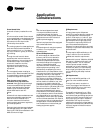
15UH-PRC002-EN
Application
Considerations
Heat
Fumes
Humidity
Contractors must also be aware of the
conditions at the point of termination.
The National Fuel Gas Code NFPA 54/
ANSI Z223.1-1992 mandates that vent
system should terminate at least 4 feet
below, 4 feet horizontally or 1 foot above
any window, door, or gravity inlet to a
building. Termination with a vent cap
approved by the manufacturer should
occur well above the snow line.
Beyond satisfying the codes, vents
should be positioned away from shrubs
and plants that might be affected by
unseasonable warming by the exhaust.
Sidewall vents release a considerable
amount of water vapor that may
condense on cold siding, adversely
affecting painted surfaces. Placing these
vents in locations that get natural air
circulation from prevailing winds may
help to reduce these negative effects.
Separated Combustion Venting
Another form of mechanical venting
includes those unit heaters that use a
powered exhaust also to pull in outside
air. Most often found on condensing
furnaces, separated combustion does
not use room air for combustion. Instead
these unit heaters use a second run of
pipe to supply fresh outdoor air.
The separated combustion approach
offers several advantages. First, it does
not use warm indoor air to fire the unit
heater. This saves energy by avoiding
drawing unheated make-up air into the
living space. Second, the unit heater has
an unlimited source of air for
combustion. In many of the new super
insulated buildings appliances can be
starved for combustion air. In
contaminated atmospheres the use of
separated combustion unit heaters
assures that the heat exchanger sees
only non-corrosive air.
When positioning the intake and exhaust
vents on separated combustion
equipment, the intake and outlet must
mount on the same outside surface. This
ensures that any wind effects balance
out. Remember to keep the vents at least
18” apart to avoid drawing exhaust air
into the intake air.
With Trane’s separated combustion unit
heaters intake air and exhaust air run
through standard 24-gauge galvanized
pipe. Remember that separated
combustion unit heaters still have high
vent temperatures. Use of PVC, CPVC
and other plastic vent materials are
inappropriate and hazardous. Check the
manufacturer’s instructions before
piping any appliance.
The vent gases of power vented and
separated combustion unit heaters may
condense on a cold start-up or when
vent piping runs through unheated
areas. To protect the heater always pitch
both intake and exhaust piping toward
the outside of the building. Remember
also that no power vented equipment
can share a common flue with any other
appliance. Should a flue become blocked
one appliance could vent into the
occupied space.
Approved vent caps should be used on
both the intake and exhaust
terminations. For greater convenience
Trane offers a concentric vent adapter
that allows venting through a single
perforation through the building wall or
roof.
Opportunities Using Trane Gas Products
Whatever venting configuration your job
requires, Trane offers a unit heater to
meet your needs. Trane offers the
reliability of traditional standing pilot
systems, always vented by natural draft.
We offer spark ignition natural draft and
power vented unit heaters and the new
separated combustion unit heaters.
(Venting
Unit Heaters)


















